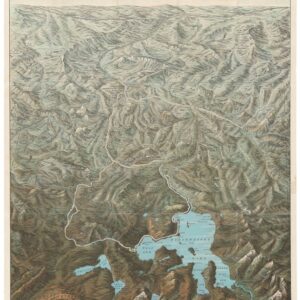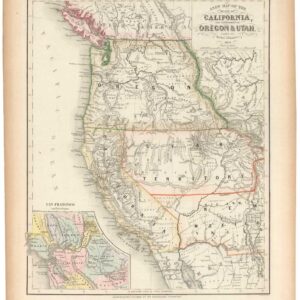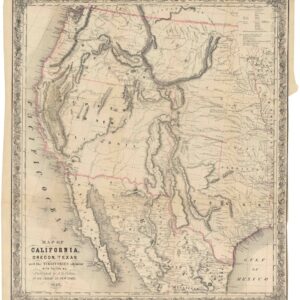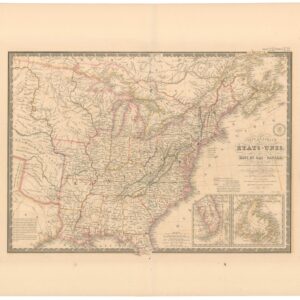Iconic 1856 map of East Kansas, published just a month after the sacking of Lawrence and in the midst of the tumultuous ‘Bloody Kansas’ era.
Map of Eastern Kansas.
Out of stock
Description
This rare and historically significant map of East Kansas from 1856 is one of the most poignant manifestations of anti-slavery sentiment in the Antebellum era. It was produced by prominent abolitionists Albert D. Searl, Edmund Burke Whitman, and John Punchard Jewett. It was published only a month after the dramatic sacking of the town of Lawrence by pro-Slavery brigands known as Border Ruffians. While issued in the direct aftermath of the sacking, the mapmakers conceived and published the map as part of an extensive propaganda campaign to convert the newly established Kansas Territory (1854) into a so-called ‘Free State’; that is, a part of the United States in which slavery was illegal.
Measuring nearly 22 inches wide by 27.5 inches tall, the map covers the eastern part of the new Kansas Territory. Five years after this map was issued, and just a few short months before the country descended into civil war, this region would formally receive statehood. However, between 1854 and 1858, Kansas was the epicenter of considerable political turmoil and violent conflict, earning the period the moniker “Bleeding” or “Bloody” Kansas Era from many prominent East Coast newspapers.
This masterpiece of American regional mapping was published in the midst of this tumult, and it paints a vivid picture of the realities on the ground. The area covered stretches from Kansas City, where the Kansas and Missouri Rivers merge in the east, to the 6th Principal Meridian in the west. The map includes the border of the Nebraska Territory, extending from the north to the 6th Parallel in the south (corresponding roughly to the modern border with Oklahoma).
General Land Agents Albert D. Searl and Edmund Burke Whitman, abolitionists who had moved to Lawrence from Massachusetts to ensure its inception in the Union as a Free State, initially commissioned the map. Searl had a surveyor’s background and had played a role in plotting the town of Lawrence. While Searl thus is likely to have compiled the map, it was published in Massachusetts by the well-known abolitionist publisher John Punchard Jewett. Jewett, in turn, contracted Lodowick Harrington Bradford to engrave and print the map in Boston.
Following its formal recognition as a U.S. Territory in 1854, Kansas became the theatre of an epochal struggle between abolitionists and slave-owners. At this stage, it was not yet clear which side of the slavery question Kansas would take, and both pro and con parties strongly encouraged the immigration of new settlers to the state to win the territory for their side. As ardent abolitionists, the cartographers behind this map hoped that it would help draw fellow abolitionists from the North and formerly enslaved people from the South. The aim was to ensure that Kansas would eventually become a Free State. These efforts had an enormous impact on where enslaved people fleeing the plantations of the South would head. In the years leading up to the Civil War, Kansas gained a reputation as a place where people of African descent could live in relative safety, and this map played a significant role in solidifying that impression.
As a map intended to spur immigration to Kansas, several features take on particular meaning. For example, areas of the map highlighted in color represent Indian lands. The reason these specific lands have been so visually well-defined was, of course, to warn new settlers so that they would avoid the regions in which so many bloody confrontations took place. This notion is further emphasized by the inclusion of an inset in the lower-left corner of the map, which provides a more detailed plan of the U.S. Government Reservation centered on Fort Riley and designates it as the geographical center of the ‘U.S. Possessions’.
Along the bottom of the map, next to the inset of Fort Riley, we find beautifully engraved vignettes, which further embody the spirit behind this iconic map. These are the Constitution Hall in Topeka and the Eldridge House in Lawrence: two historic ‘Free State’ institutions of Kansas. Topeka’s Constitution Hall was built in 1855 and constituted the venue where the Topeka Constitutional Convention met and produced the anti-slavery Constitution of that year. On either side of this image, we find the Eldridge House in Lawrence, which was built by a Boston transportation company following the Kansas-Nebraska Act, which made the Kansas Territory a reality.
The Eldridge House was a boarding house where Free-Staters moving to Kansas could stay until they had set up a life for themselves. It was considered a staging ground for the Free-State movement and soon became a target for the pro-slavery forces at work in the state. When Lawrence was sacked by Douglas County Sheriff Samuel J. Jones and his gang of pro-slavery activists in May of 1856, the Eldridge House was one of the first buildings to be burned to the ground. The double vignette depicts both the havoc wreaked by pro-slavery forces in Lawrence and the resilience and determination of its abolitionist inhabitants.
The attack on Lawrence played a decisive role in luring pro-abolitionist New Englanders to Kansas and was thus a significant event in the history of Kansas. While the mapmakers had to be careful not to deter potential emigrants, the event is still referenced on the map. Lawrence is the only town on the map denoted by a large, blood-red circle with an American flag, honoring the dead. In three locations around Lawrence – on the westbound road to Franklin, on the northern road towards Fort Leavenworth, and to the east, outside the pro-slavery stronghold of Lecompton – the map notes the presence of “Shannon’s Posse”: pro-slavery militias organized under the similarly inclined Democrat governor of Kansas, Wilson Shannon.
This rare and historically significant map of East Kansas from 1856 is one of the most poignant manifestations of anti-slavery sentiment in the Antebellum era. It was produced by prominent abolitionists Albert D. Searle, Edmund Burke Whitman, and John Punchard Jewett. It was published only a month after the dramatic sacking of the town of Lawrence by pro-Slavery brigands known as Border Ruffians. While issued in the direct aftermath of the sacking, the mapmakers conceived and published the map as part of an extensive propaganda campaign to convert the newly established Kansas Territory (1854) into a so-called ‘Free State’; that is, a part of the United States in which slavery was illegal.
Measuring nearly 22 inches wide by 27.5 inches tall, the map covers the eastern part of the new Kansas Territory. Five years after this map was issued, and just a few short months before the country descended into civil war, this region would formally receive statehood. However, between 1854 and 1858, Kansas was the epicenter of considerable political turmoil and violent conflict, earning the period the moniker “Bleeding” or “Bloody Kansas Era” from many prominent East Coast newspapers.
This masterpiece of American regional mapping was published in the midst of this tumult, and it paints a vivid picture of the realities on the ground. The area covered stretches from Kansas City, where the Kansas and Missouri Rivers merge in the east, to the 6th Principal Meridian in the west. The map includes the border of the Nebraska Territory, extending from the north to the 6th Parallel in the south, which roughly corresponds to the modern border with Oklahoma.
General Land Agents Albert D. Searl and Edmund Burke Whitman, abolitionists who had moved to Lawrence from Massachusetts to ensure its inception in the Union as a Free State, initially commissioned the map. Searl had a surveyor’s background and had played a role in plotting the town of Lawrence. While Searl thus is likely to have compiled the map, it was published in Massachusetts by the well-known abolitionist publisher John Punchard Jewett. Jewett, in turn, contracted Lodowick Harrington Bradford to engrave and print the map in Boston.
Following its formal recognition as a U.S. Territory in 1854, Kansas became the theatre of an epochal struggle between abolitionists and slave-owners. At this stage, it was not yet clear which side of the slavery question Kansas would take, and both pro and con parties strongly encouraged the immigration of new settlers to the state to win the territory for their side. As ardent abolitionists, the cartographers behind this map hoped that it might help draw fellow abolitionists from the North and formerly enslaved peoples from the South. The aim was to ensure that Kansas would eventually become a Free State. These efforts had an enormous impact on where enslaved people fleeing the plantations of the South would head. In the years leading up to the Civil War, Kansas gained a reputation as a place where people of African descent could live in relative safety, and this map played a significant role in solidifying that impression.
As a map intended to spur immigration to Kansas, several features take on particular meaning. For example, areas of the map highlighted in color represent Indian lands. The reason these specific lands have been so visually well-defined was, of course, to warn new settlers so that they would avoid the regions in which so many bloody confrontations took place. This notion is further emphasized by the inclusion of an inset in the lower-left corner of the map, which provides a more detailed plan of the U.S. Government Reservation centered on Fort Riley and designates it as the geographical center of the ‘U.S. Possessions’.
Along the bottom of the map, next to the inset of Fort Riley, we find beautifully engraved vignettes, which further embody the spirit behind this iconic map. These are the Constitution Hall in Topeka and the Eldridge House in Lawrence: two historic ‘Free State’ institutions of Kansas. Topeka’s Constitution Hall was built in 1855 and constituted the venue where the Topeka Constitutional Convention met and produced the anti-slavery Constitution of that year. On either side of this image, we find the Eldridge House in Lawrence, which was built by a Boston transportation company following the Kansas-Nebraska Act, which made the Kansas Territory a reality.
The Eldridge House was a boarding house where Free-Staters moving to Kansas could stay until they had set up a life for themselves. It was considered a staging ground for the Free-State movement and soon became a target for the pro-slavery forces at work in the state. When Lawrence was sacked by Douglas County Sheriff Samuel J. Jones and his gang of pro-slavery activists in May of 1856, the Eldridge House was one of the first buildings to be burned to the ground. The double vignette depicts both the havoc wreaked by pro-slavery forces in Lawrence and the resilience and determination of its abolitionist inhabitants.
The attack on Lawrence played a decisive role in luring pro-abolitionist New Englanders to Kansas and was thus a significant event in the history of Kansas. While the mapmakers had to be careful not to deter potential emigrants, the event is still referenced on the map. Lawrence is the only town on the map denoted by a large, blood-red circle with an American flag, honoring the dead. In three locations around Lawrence – on the westbound road to Franklin, on the northern road towards Fort Leavenworth, and to the east, outside the pro-slavery stronghold of Lecompton – the map notes the presence of “Shannon’s Posse”: pro-slavery militias organized under the similarly inclined Democrat governor of Kansas, Wilson Shannon.
Context is everything: ‘Bleeding Kansas’ and the Sacking of Lawrence in 1855
The term ‘Bleeding Kansas’ was coined by abolitionist newspapers in New York. It corresponds to a period generally considered to span from the creation of Kansas Territory in 1854 until roughly 1858, when the worst of the strife subsided following government intervention. Despite being a localized phenomenon, the history of Kansas during those years was ultimately a reflection of an inevitable national confrontation on the issue of slavery. In this sense, both the Bleeding Kansas conflict and the publication of this map constituted events of national importance, in line with contemporaneous events that have achieved iconic stature in American history, such as the Dred Scott ruling (1857) or the Lincoln-Douglas debates (1858).
Kansas became one of the main battlegrounds on which the philosophical and moral struggle of the Antebellum Era played out. Whether or not Kansas was to be a Free State was, in a greater sense, the question of whether the United States should be a ‘Free Nation.’ When Kansas finally proclaimed statehood as a Free State in January 1861, it tipped the conflicted U.S. Congress in favor of abolition. President Lincoln assumed office just a month later, followed by the secession of the southern states from the Union. The flames quelled in Kansas would now ignite the entire nation in the Civil War.
Kansas was, in other words, the prelude to America’s great fraternal conflict. It began with the establishment of the Kansas Territory in 1854, which came with a provision of ‘Popular Sovereignty,’ meaning that its inhabitants, including incoming settlers, would have to vote on whether Kansas would be a ‘free’ or a ‘slave’ state. The provision nevertheless did not set a time limit for such a referendum, prompting the respective parties to delay the matter long enough to sway the vote in their favor. Such a vote would set the trajectory for Kansas’ development as a state and would likely spill over into the national debate as well. Consequently, winning in Kansas was deemed hugely important by East Coast abolitionists and Southern slave-owners. The attempt to dominate demographics through immigration and thereby decide the outcome of the slavery question led both sides to launch a campaign encouraging immigration and settlement in Kansas. This map is a vital part of the abolitionist effort.
As a result of these endeavors, immigrants supporting both sides of the question flooded into Kansas in the hope of commandeering the vote. Inevitably, the contest first turned sour and then violent. Due to the national implications of the outcome, politicians in Washington closely monitored the situation and delivered passionate speeches for and against it on the Senate floor. While the Republicans, with Lincoln at their head, leaned increasingly towards abolition, the Democrats fought long and hard to preserve slavery. The Kansas question was such a heated topic in Washington that Senator Charles Sumner from Massachusetts was almost caned to death by a congressman from South Carolina on the Senate Floor about a month before this map’s publication.
In Kansas, two opposing forces emerged. Pro-slavery raiders known as the ‘Border Ruffians‘ rode across the border from the neighboring slave state of Missouri. The main opposition came from the abolitionist ‘Free-Staters,’ most of whom had resettled in Kansas from New England. Many of the Free-Staters concentrated in towns and cities, particularly Lawrence, which was founded on the banks of the Missouri River by Free-Staters from Massachusetts. Among its most prominent citizens were the authors of this map. In Lawrence, incoming northern abolitionists could live in relative safety from the ‘Ruffians’ that roamed the countryside. But the situation soon became untenable, and by the summer of 1855, tensions erupted into open violence.
The conflict reached its climax in the spring of the following year, just as this map was prepared for publication. In August of 1855, President Franklin Pierce, a pro-slavery Democrat from New Hampshire, appointed Wilson Shannon, a fellow pro-slavery northerner or doughboy, as the new territorial governor of Kansas. The appointment was naturally perceived as presidential support for the pro-slavery agenda and immediately caused an increase in politically motivated violence throughout the Territory. Shannon even used the U.S. cavalry stationed at Fort Riley and Fort Leavenworth to enforce his agenda. The political support from Washington emboldened some, and on May 21st, 1856, the sheriff of Douglas County led a devastating raid on Lawrence. The mob ransacked large parts of the town and set ablaze businesses and homes. Among the architectural victims was the Eldridge House, depicted twice at the bottom of this map, once in its original state and once in its ruined state.
Despite its viciousness, the attack on Lawrence did not deter the Free Staters from continuing their struggle to win Kansas. It provided a prescient need for further immigration of the right kind, and shortly after the attack, a new wave of Free-Stater propaganda was launched. Much of this was built on the outrage that the sack of Lawrence generated on the East Coast. Issued only a month after the attack, our map played a crucial role in this new campaign. The abolitionists of Lawrence had to tread carefully, though: on the one hand, the indignant mood could be used to attract new settlers, but on the other, one had to be careful not to put too much emphasis on the fighting. New England families would hardly be inclined to move into a war zone.
Instead, the mapmakers emphasized the assistance and infrastructure available to anyone considering the big move. This is why Eldridge House is not only shown in its ruined state but also as it would look once rebuilt. The most explicit offer of assistance was nevertheless found on the original slipcase to the map (now lost?), which included an advertisement for Whitman and Searle as General Land Agents and stipulated the kinds of services and expertise New England immigrants could expect to find in Lawrence.
In summary, this map encapsulates one of the most critical processes in American history and, in many ways, serves as a regional reflection of the national reality. It is a map that offers some redemption to the otherwise deep and dark despair that stains America’s history. It demonstrates most palpably that even in her darkest hour, America not only had citizens willing to fight for abolition, but also was willing to die for it.
Census
This extraordinary and historically significant map is generally scarce on the market. The OCLC (no. 83986968) lists examples in several institutional collections, including those at Harvard, Yale, Princeton, and the University of Michigan. Similarly, an example is held in the David Rumsey Collection at Stanford (List no. 3069.001) and the Norman B. Leventhal Map Center at the Boston Public Library (Call no G4200 1856 .W55).
Cartographer(s):
Albert D. Searl (1831-1902) was an American surveyor, civil engineer, and abolitionist active in Kansas during the ‘Bloody Kansas’ period (1854-58).
Born in Southampton, Massachusetts, Searl moved to Kansas in 1854, where he played a central role in laying out the town of Lawrence. In 1856, he partnered up with another Lawrence pioneer, Edmund Burke Whitman, to become General Land Agents for abolitionist-minded settlers from the East Coast. The pair published an essential map of Eastern Kansas shortly after the sacking of Lawrence in May 1856.
During the Civil War, Searl was commissioned as a 2nd Lieutenant in the Union Army’s 9th Kansas Cavalry Regiment. After the war, Searl remained in Lawrence until 1882, when he moved to Leadville, Colorado to become head surveyor for the Rio Grande Railroad out of Denver. Searl died in 1902.
Edmund Burke WhitmanEdmund Burke Whitman (1812-1883) was an American military officer and General Land Agent in Kansas during the so-called ‘Bloody Kansas’ era (1854-58). He was born in Massachusetts and was educated at Harvard, graduating in 1838. During his time at university, Burke developed strong abolitionist sentiments, which were central to his decision to uproot his family and move to Lawrence, Kansas, in 1855. He became a vocal Free Stater, fighting against the pro-slavery forces from especially Missouri.
The following year, Whitman partnered up with fellow New Englander Albert D. Searle to establish a Land Agent Company that assisted immigrants with resettling in Kansas. As part of this work, they published an important map of Eastern Kansas shortly after the sacking of Lawrence by pro-slavery ruffians.
During the Civil War, Whitman served as quartermaster for the Union Army, and he was subsequently appointed Superintendent of National Cemeteries, a job that entailed recovering the remains of more than 100,000 fallen Union soldiers from the southern theaters of war.
John Punchard JewettJohn Punchard Jewett (1814-1884) was an American publisher and abolitionist active in Boston in the middle part of the 19th century. As a young man, Jewett was trained as a bookbinder in Salem, eventually becoming a partner in the firm. From the mid-1830s, Jewett became increasingly active in the abolitionist movement, publishing pamphlets and treaties denouncing slavery and joining the first Anti-Slavery Society in New England.
Around 1849, Jewett relocated to Boston, where he took on several now-famous manuscripts for publication. The most famous of these was Harriet Beecher Stowe’s classic, Uncle Tom’s Cabin, but he also published several maps, including a historically significant chart of East Kansas in 1856 (only a month after the sacking of Lawrence).
Lodowick Harrington BradfordLodowick Harrington Bradford (1820-1885) was a Boston-based engraver and lithographer active in the second half of the 19th century. Bradford was a native Bostonian and one of the first to engage commercially in the new art of lithography. He was behind several printing innovations, including a photo-lithographic process that created a durable ambrotype picture on a lithographic stone. In 1849 he partnered with Ebenezer Tappan and formed the firm of Tappan and Bradford, which remained active until Tappan’s death in 1854.
Between 1854 and 1859, Bradford continued the firm but now published under the imprint ‘L. H. Bradford and Company.’ Among his most important output from this period is a historical map of Eastern Kansas meant to draw anti-slavery immigrants to the new Territory. From 1859 until 1870, the imprint was reduced to ‘L. H. Bradford’. In addition to creating photographic and other types of lithographs, Bradford published steel and copper engravings, including of local artists like Fitz Henry Lane. He died in 1885.
Condition Description
Wear along fold lines, discoloration; repair tape visible on verso; minor infiling along folds.
Comes with original brown cloth covers, covers decoratively blocked in blind, upper cover titled in gilt, printed letter by Whitman and Searl on the inside front pastedown.
References
Baughman, R. W., (1961). Kansas in Maps. Topeka: Kansas State Historical Society.
Heaston, M., (1980). The Kansas pocket map, the cartographer’s orphan. Yale University Library Gazette 54: 168-181 (map no. 4).
Jones, Herschel V. (1964), ADVENTURES IN AMERICANA 1492-1897: The Romance of Voyage and Discovery from Spain to the Indies, the Spanish Main, and North America; Inland to the Ohio Country; on Toward the Mississippi; through to California; over Chilcoot Pass to the Gold Fields of Alaska. New York: Cooper Square Publishers (#1354).



